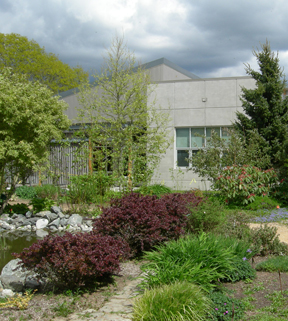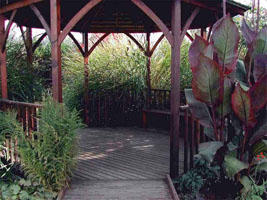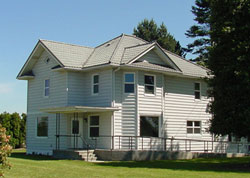About WSU Mount Vernon
WSU Mount Vernon NWREC is located in the Skagit Valley of northwestern Washington, midway between Seattle, WA and Vancouver, B.C. The region is well known for its scenic beauty, the Cascade Mountain Range, and Puget Sound. The immediate five-county area supports a diverse agriculture, including dairy and livestock industries, and the production of over 60 fresh-market and processing crops on roughly more than 100,000 acres. Blueberries, red raspberries, strawberries; cabbage, spinach, table beet and more than 20 other vegetable and grass seed crops; cucumbers, green peas, red and yellow potatoes, and specialty vegetables; apple and grape and other specialty fruit cultivars; tulips, daffodils and irises; turf, nursery and greenhouse crops; and, various small grain crops flourish here because of the rich soils and mild, marine climate. WSU Mount Vernon receives support from the allied agricultural and horticultural industries, small farmers, and garden enthusiasts. Preservation of open space and farmland in an urbanizing environment is a key issue for the region.
16650 State Route 536, Mount Vernon, WA 98273 | 360-848-6120
Mission
The mission of Washington State University Mount Vernon Northwestern Washington Research & Extension Center is to serve the agricultural, horticultural, and natural resource science interests of the state through research and extension activities that are enhanced by the unique conditions of western Washington: its mild, marine climate, rich alluvial soils, diverse small and mid-sized farming enterprises, and unique rural-urban interface.
History
WSU Mount Vernon NWREC is one of four off-campus WSU Research Centers operated by the College of Agricultural, Human and Natural Resource Sciences. Established in 1947, WSU Mount Vernon has a long tradition of serving western Washington’s agricultural and horticultural communities. During the early years of WWII, WSU and USDA scientists working in the area were able to successfully control devastating diseases of beet and cabbage that were being grown for seed. Impressed by the value of research-based information, the community, including farmers, seed companies, processing firms and civic groups raised funds for a permanent facility. The facilities have continued to grow and improve over the years and in 2006, the new Agricultural Research & Technology Building opened. The vision for the building as a full-service research center was led by members of northwestern Washington’s agricultural community in collaboration with WSU and augmented by public appropriations and gifts reaching nearly $2.25 M. The efforts and partnerships here are truly unique, and considered a model for revitalizing R&E Centers throughout the U.S.
View pictures and video of the celebration (December 6, 2016)
Research Programs
The Center houses research programs for entomology, small fruit horticulture, vegetable horticulture, vegetable pathology, vegetable seed pathology, weed science, and plant breeding. Cooperative research between scientists at WSU Mount Vernon NWREC and other sites, as well as regional, national and international collaboration, enhances the work of all. Currently, collaborative projects on alternative crops, bio-degradable mulches, high tunnel systems, pest and disease control measures for conventional and organic production systems, riparian buffers, specialty fruits and vegetables, and various bio-fuel crops are generating results that are applicable throughout the Pacific Northwest. Cooperative and interdisciplinary research activities involve personnel in WSU’s Northwest Extension District, other WSU locations in the state, faculty at other universities, and various public agencies, organizations and volunteer groups. Research activities are funded by grants obtained from local, regional, national, and international sources.
Faculty and Staff
The main objectives of the faculty and staff at WSU Mount Vernon NWREC are to solve plant-related problems, and develop cost-effective and environmentally-sound plant production practices based directly on results from experimental field, greenhouse and laboratory research trials. Faculty and staff work hard to educate stakeholders at workshops and field days, and via demonstration gardens and written and web-based materials.
NWREC Facilities
The Agricultural Research & Technology Building

Completed in 2006, the Agricultural Research & Technology Building includes offices, modern laboratories, greenhouse bays, a public auditorium and demonstration kitchen, distance learning and video teleconferencing capabilities. The Sakuma Auditorium and kitchen can be reserved for approved events.
WSU Apiary and Display Gardens

WSU Mount Vernon NWREC hosts a Volunteer Display Garden which occupies 10 acres of land involving WSU Skagit County Master Gardeners, Salal Chapter of the Washington Native Plant Society, and Western Washington Fruit Research Foundation. The purpose of the Garden is to provide educational opportunities for the public through hands-on viewing, exhibits and gardening experiences. In addition, an apiary is maintained on the farm with the assistance of the Washington State Beekeepers Association, the Skagit Valley Beekeepers Association, the Northwest District Beekeepers Association, the Stanwood-Camano Beekeepers Association, and the Mt. Baker Beekeepers Association.
Olson Heritage Farm House

The 2004 renovation of the Olson Heritage Farm House provides housing for WSU graduate students and visiting scientists. Originally built in 1913 by Anders Olof (Andrew) and Maria Olson at a cost of $2,000, the house and surrounding eight acres were purchased by the Skagit Farm Bureau in 1999 as part of the “Land Security” project to ensure the future of research at the Center. Senator Patty Murray led the effort to secure HUD funds to reimburse the Farm Bureau. That year, Mr. Allan Osberg of Seattle, Olson’s grandson, donated $155,000 to Skagitonians to Preserve Farmland to renovate the house in memory of his grandparents. In 2003, the property was transferred to WSU and the house was remodeled to university standards.